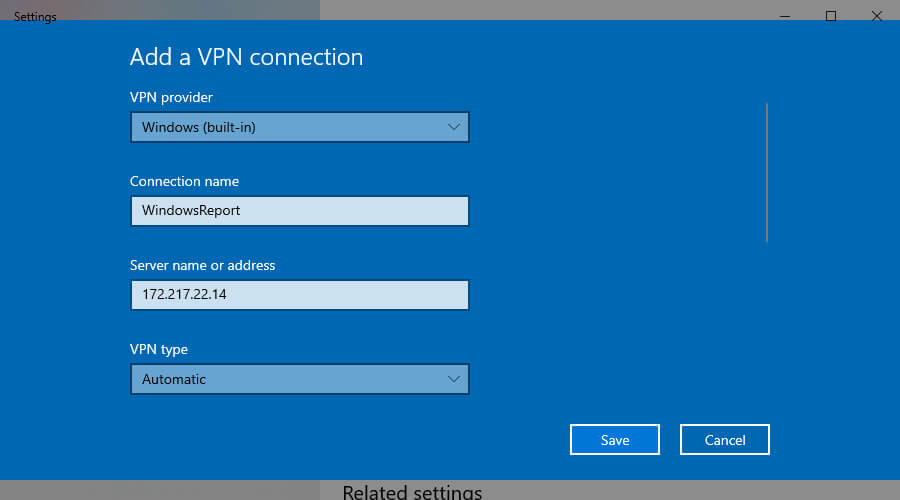- Set up a PPTP VPN connection on Windows 10 to remotely connect to the workplace, use Remote Desktop to control a PC through the Internet, or turn your home PC into a VPN server. Find out how.
- Although PPTP has a few perks, like great connection speed and native support with most devices, its disadvantages make it the wrong VPN protocol for online security and privacy. Find out why.
- Join our Windows 10 section to master Microsoft’s operating system in no time.
- For more VPN guides and how-to articles, bookmark our VPN Troubleshooting Hub.

PPTP is the oldest protocol implemented by Microsoft (in 1995). And most platforms have native support for PPTP, including Windows, Mac, Android, and iOS.
As such, you might be interested in setting up a PPTP VPN connection on Windows 10 or other operating systems. Creating a VPN connection over PPTP is practical for several reasons.
For example, a company’s network administrator can set up a VPN server over PPTP to allow employees to remotely connect to the office and use the intranet resources, including files and printers.
It’s also possible to set up a VPN with Remote Desktop to remotely access a personal computer that’s in another network. Or you can simply connect to a VPN on your laptop through PPTP to enhance your online privacy and security.
Whatever your reasons are, you need to setup a VPN at home through the PPTP protocol. The best part about it is that you don’t have to install any software since you can configure the Windows 10 VPN settings.
What is PPTP VPN?
PPTP VPN is a virtual private network client that uses the Point-to-Point Tunneling Protocol to connect to the VPN server. It uses port 1723 over TCP and GRE (IP protocol 47). That means you have to open firewall ports to allow PPTP traffic from and to your PC.
Here are the advantages and disadvantages of using PPTP VPN connections.
- Pros
- Most devices have native support for PPTP, including routers
- Speedy and stable connections, ideal for streaming
- A perfect fit for older computers with weak hardware
- Cons
- An obsolete VPN protocol due to low security
- Can be easily blocked by firewalls
- Not suitable for business use
- 1
Create a PPTP VPN connection
- Right-click the Start button and go to Network Connections.
- Select VPN.
- Click Add a VPN connection.
- Set VPN provider to Windows (built-in).
- At Connection name, type a display name.
- Set Server name or address, write the VPN server.
- At VPN type, select Point to Point Tunneling Protocol (PPTP).
- Set Type of sign-in info to User name and password*.
- Write your VPN credentials at User name (optional) and Password (optional).
- Check Remember my sign-in info.
- Click Save.
*You can also set up a PPTP VPN connection on Windows 10 using a smart card, one-time password, or certificate authentication. However, the username-and-password combination is more common.
If you wish to connect to the VPN as soon as your PC connects to the Internet at startup, you can make Windows 10 automatically connect to VPN.
But if you want to be thorough about it and make sure your IP address doesn’t get leaked in the time it takes you to input your PIN or login credentials, you can make Windows 10 connect to VPN before logon.
- 2
Connect to the PPTP VPN
- Click the network icon in the systray.
- Select your PPTP VPN connection.
- Click Connect.
- Ask Google what’s your IP address to see if it changed.
As you can see, connecting to the PPTP VPN is as easy as joining a Wi-Fi network. However, if the PPTP VPN is not connecting on Windows 10, make sure to fix this problem.
For example, if your VPN connection gets blocked by Windows Firewall, you need to configure advanced firewall settings and enable a rule for PPTP. On the other hand, if you receive VPN error 619, you might have entered the wrong login data.
To remotely access a PC on another network through the Internet by setting up a PPTP VPN with Remote Desktop, you need a router that supports PPTP connections.
But if you want to protect your online privacy and security, we suggest using a more secure VPN protocol like OpenVPN and a premium VPN client like Private Internet Access.
Why use Private Internet Access
Operated by Kape Technologies, Private Internet Access (PIA) is a VPN service tat delivers premium security features for your entire household. It’s also the best VPN for Battlefield 4.
PIA supports OpenVPN and WireGuard protocols to protect your online identity and defend your router from hackers. But you can also use the PPTP account credentials provided by PIA to set up a VPN connection on your Windows 10 PC.
The tool supports exclusive DNS servers, 10 simultaneous connections, port forwarding, a kill switch, and split-tunneling mode. You can also install it at the router level to share VPN access with all connected devices.
What else you should know about PIA:
- +3,300 VPN servers in 48 countries
- Optimized for streaming and torrenting
- No logs
- 24/7 live chat support
- 30-days money-back guarantee (no free trial)

Private Internet Access
Enjoy secure browsing, anonymous torrenting, lag-free gaming, and unlimited streaming by using PIA.
$2.85/mo. Buy it now
To summarize, you can effortlessly set up a PPTP VPN connection using the Windows 10 built-in VPN provider, without having to install any additional software.
It’s a great way to remotely connect to the workplace, gain access to your company’s internal resources, and access files through the VPN.
However, if you want to get a VPN to increase your privacy on the Internet, we strongly discourage using the PPTP protocol because it’s terrible at security and can be easily hacked.
Instead, use a modern VPN protocol like OpenVPN.



